Welcome to Cosmographia. This post is part of our series on Symbology. For the full map of posts, see here.
The world is filled with aether. It permeates the interstices of atoms. Aether is everywhere. How dense is the aether? Is it fluid like water or rigid like steel? How fast is our earth moving through it?
— Sir Arthur Eddington, New Pathways in Science (1935)
In Greek mythology, Aether was the personification of the bright upper sky. His parentage differs depending on who you read: Hesiod has him as the son of Erebus (Darkness) and Nyx (Night); while the Orphics believed him the offspring of Chronos (Time), brother to Erebus and Chaos; still others described Aether as fathering Uranus (Sky), making him the ancestor of all other gods.
The fifth Orphic Hymn (c. 2nd-3rd centuries AD), addresses Aether directly:
Yours are Zeus' lofty dwelling, endless power too; of the stars, of the sun, and of the moon you claim a share. O tamer of all, O fire-breather, O life's spark for every creature, sublime Ether, best cosmic element, radiant, luminous, starlit offspring, I call upon you and I beseech you to be temperate and clear.
In Homeric Greek, αἰθήρ (aithḗr) means “pure, fresh air” or “clear sky” — hence, aether was sometimes used as a synonym for air in the oldest works. However, writing centuries later, in a throwaway line in his Timaeus (c. 360 BC), Plato distinguishes between ordinary air and a translucent kind “which is called by the name of aether.” His student, Aristotle, formalised this in his On the Heavens (c. 350 BC).
According to the Athenian, aether moved only in circles, and formed the celestial spheres that moved the heavenly bodies around the cosmos in their circular motion. In his geometric model of the cosmos, the universe was divided in two: everything below the lunar sphere (containing the Moon) was formed of the four earthly elements — earth, water, air, and fire; everything above was formed of aether, a substance both eternal and divine.




